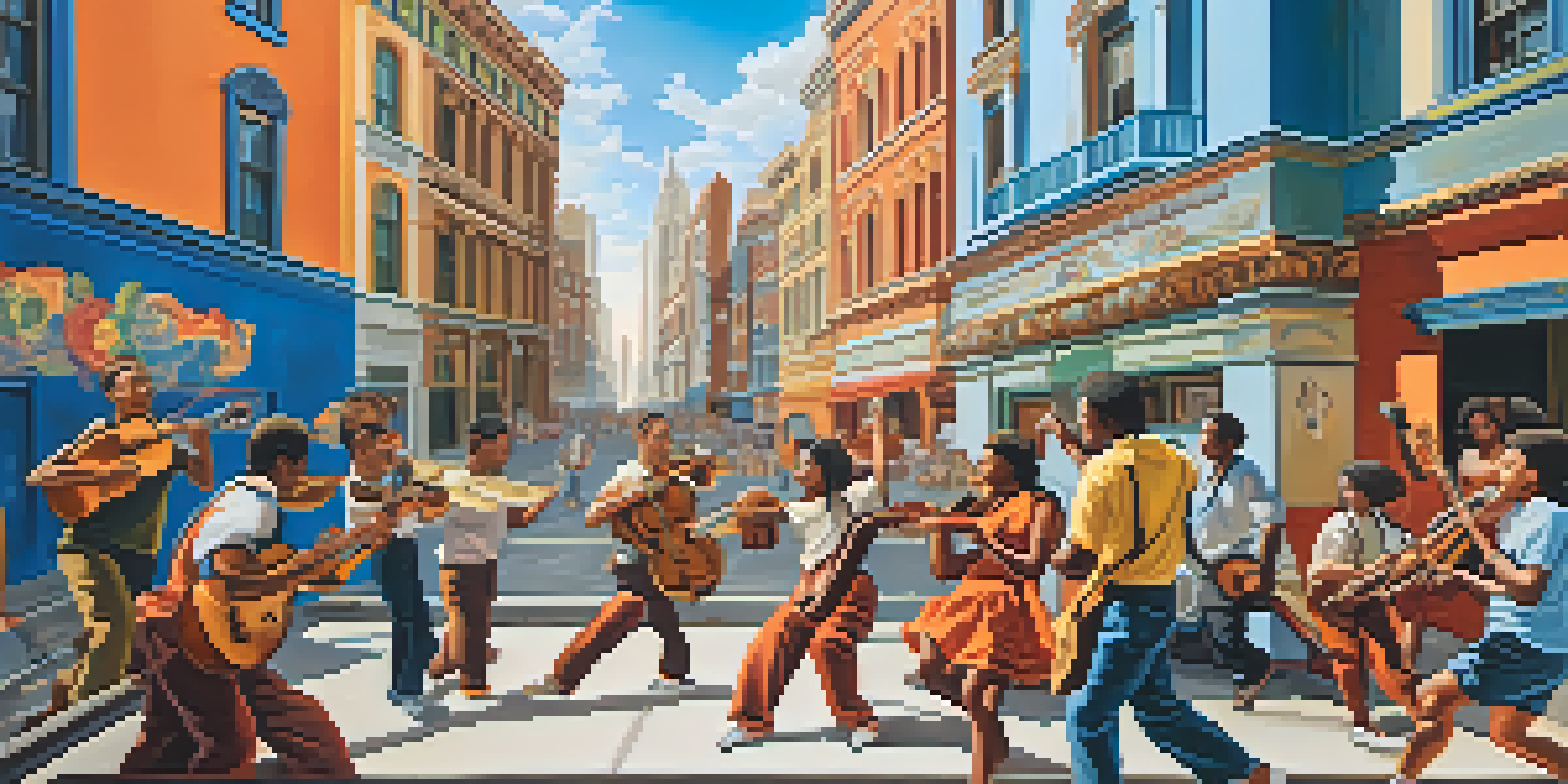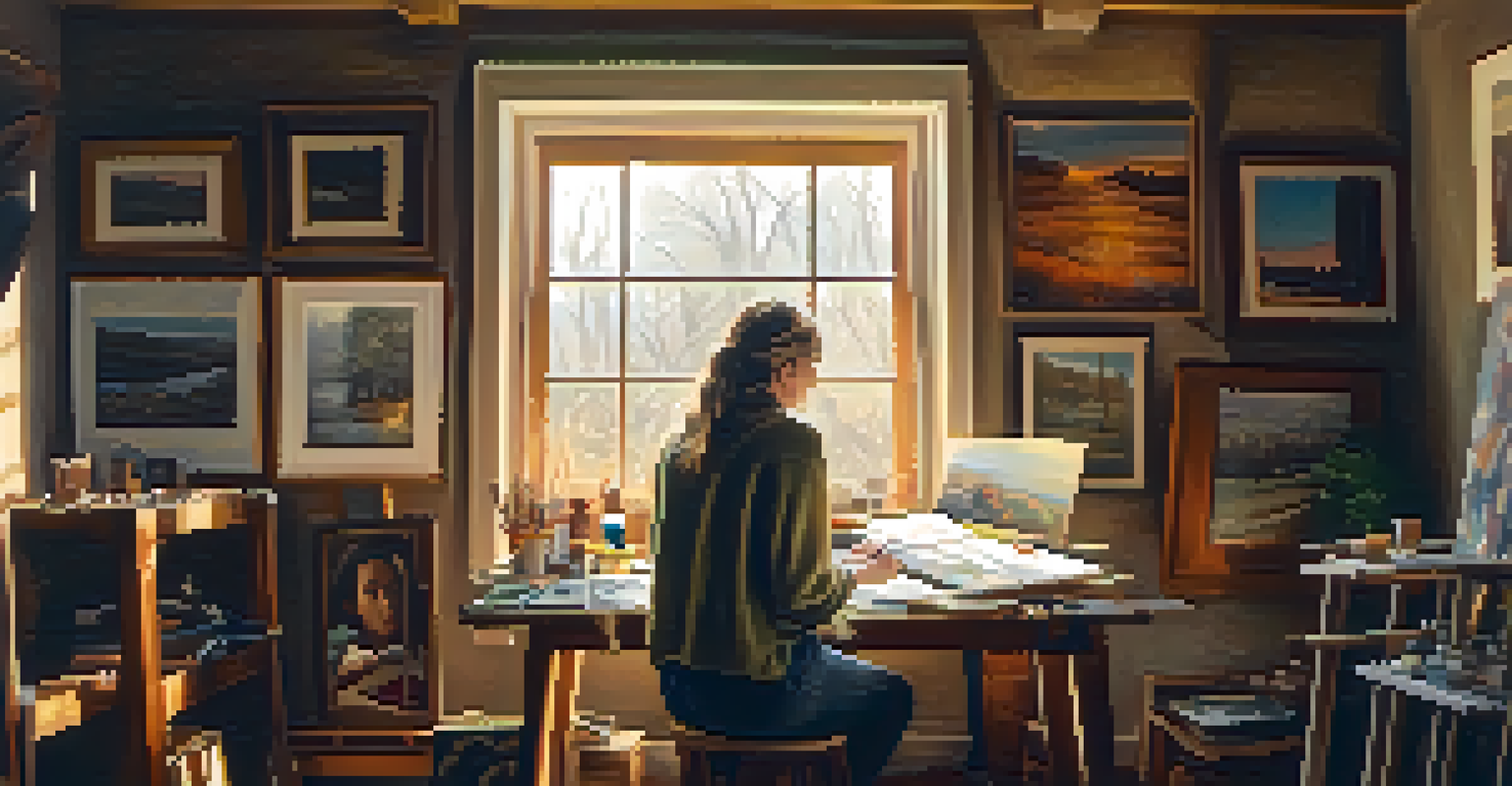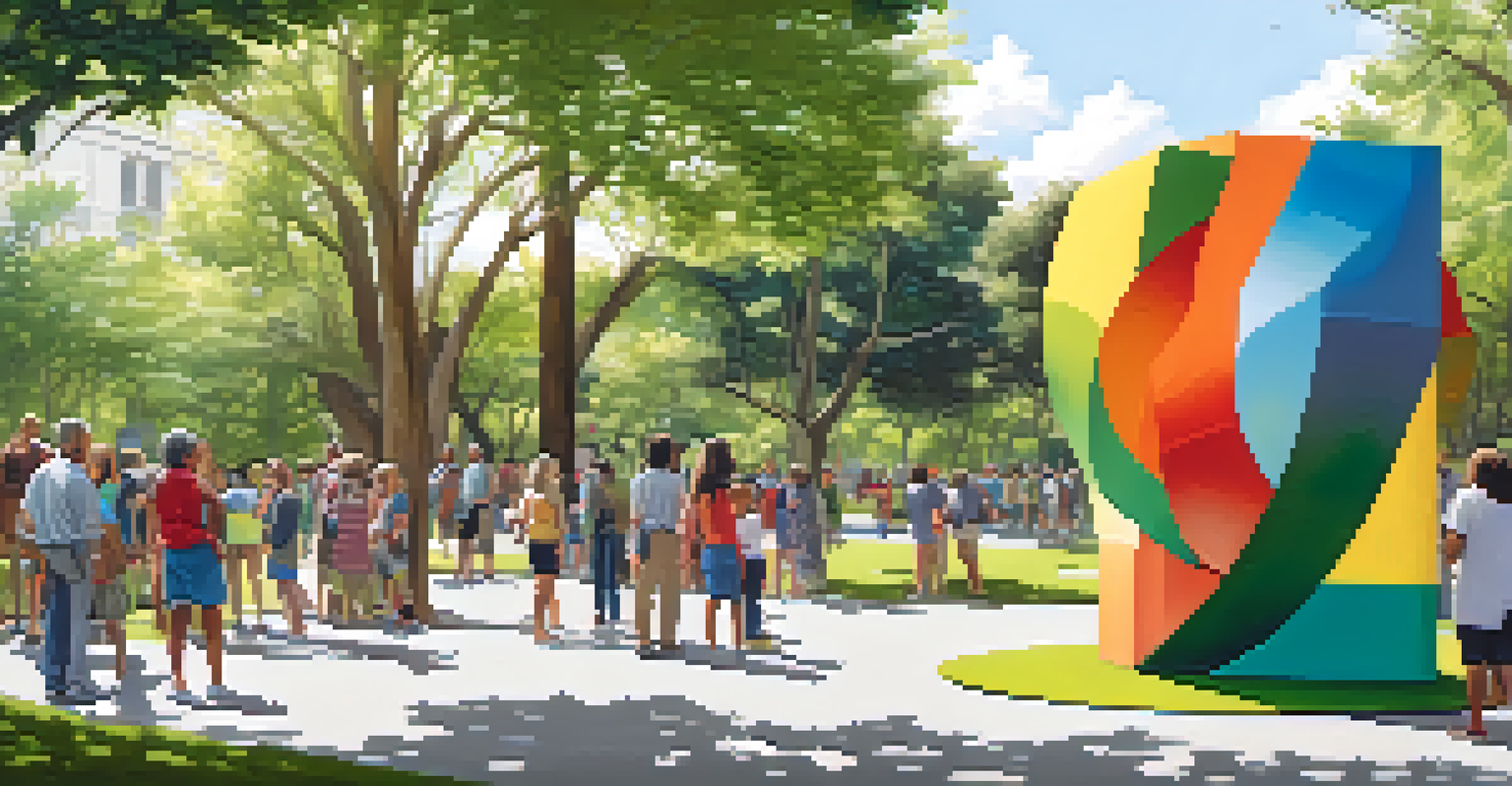Artistic Expression and Its Impact on Shared Cultural Memories

Understanding Artistic Expression and Its Forms
Artistic expression encompasses a wide range of human creativity, from painting and sculpture to music and dance. Each form offers a unique way to convey emotions, ideas, and cultural narratives. For instance, a powerful song can evoke feelings of nostalgia, while a thought-provoking painting might challenge societal norms. These various mediums allow individuals to communicate their experiences, bridging gaps between different cultures and generations.
Art is the most beautiful of all lies.
Art isn't just about aesthetics; it's a reflection of the society in which it exists. Artists often draw inspiration from their surroundings, creating works that resonate with their community's values and struggles. This connection makes art a powerful tool for sharing stories and preserving collective memories over time. Whether it's through a mural that depicts historical events or a folk song passed down through generations, artistic expression plays a critical role in shaping our cultural identity.
Moreover, the impact of artistic expression extends beyond individual experiences; it fosters a sense of belonging and shared understanding. When people engage with art, they often find common ground with others, promoting empathy and connection. This shared experience of art can lead to a deeper appreciation of cultural diversity and the stories that bind us together.
Art as a Reflection of Cultural Identity
Cultural identity is intricately linked to artistic expression, as it often embodies the beliefs, values, and traditions of a community. For example, traditional dances and crafts can serve as a celebration of heritage, illuminating the uniqueness of a culture. These artistic practices not only preserve the past but also instill pride in one's identity, encouraging future generations to keep these traditions alive.

In many cultures, art acts as a visual language that communicates collective experiences. Take indigenous art, for instance; it often tells stories of ancestral heritage, land, and spirituality. By engaging with these works, viewers gain insight into the lives and values of the artists, fostering a deeper understanding of the culture from which the art originates. This connection helps to nurture respect and appreciation for diverse cultural narratives.
Art Reflects Cultural Identity
Art serves as a powerful medium to express and preserve the beliefs, values, and traditions of diverse communities.
Through art, communities can reclaim their narratives and assert their place in history. In times of social upheaval, artistic expression can become a rallying cry, uniting individuals around a shared cause. For example, protest art has played a significant role in movements worldwide, capturing the spirit of resistance and the demand for change, thus preserving the memory of those struggles for future reflection.
The Role of Art in Preserving Shared Memories
Art serves as a vessel for preserving shared memories, allowing communities to document their histories in vibrant and engaging ways. From historical reenactments to visual storytelling, these artistic endeavors weave together individual and collective experiences, ensuring that important moments are not forgotten. For instance, documentary films often highlight pivotal events, providing a visual record that resonates with audiences long after the events have passed.
Every artist dips his brush in his own soul, and paints his own nature into his pictures.
Moreover, public art installations can transform spaces, creating lasting reminders of cultural events or shared experiences. Think of memorials or monuments; these structures encapsulate the emotions tied to significant occurrences, allowing communities to come together in remembrance. By engaging with these works, individuals can reflect on their shared history and find solace in collective grief or celebration.
This preservation of memories through art is especially crucial in a rapidly changing world. As cultures evolve, the stories and experiences that shape them may fade away without careful documentation. Artistic expression not only captures these moments but also invites dialogue, encouraging communities to reflect on their past while considering the future.
Artistic Expression as a Catalyst for Change
Artistic expression has long served as a catalyst for social and cultural change. Artists often use their platform to raise awareness about pressing issues, inspiring individuals to take action. For example, street art has emerged as a powerful medium for social commentary, addressing topics such as inequality, climate change, and human rights. These bold expressions can galvanize communities, sparking conversations that lead to tangible change.
Additionally, art can challenge existing narratives and provoke thought. When artists push the boundaries of conventional ideas, they invite others to question the status quo. Think of performance art that confronts societal norms; it can create discomfort, but it also encourages critical dialogue about important issues. This process of questioning and reflecting is essential for fostering growth within a community.
Art as a Catalyst for Change
Through artistic expression, individuals can address pressing social issues and inspire collective action for change.
Ultimately, art's ability to inspire change lies in its capacity to connect with people on a personal level. When individuals see their own experiences reflected in a piece of art, it can ignite a passion for advocacy. This shared emotional response can be the first step towards collective action, reinforcing the idea that artistic expression can be a powerful tool for transformation.
The Interplay Between Art and Memory
Memory and art are deeply intertwined, with each influencing the other in profound ways. Artistic expression can evoke powerful memories, transporting individuals back to specific moments in time. For instance, a familiar melody may trigger memories of childhood, while a particular scent might remind someone of a loved one. This interplay allows art to become a powerful vehicle for exploring personal and collective histories.
Conversely, memories can shape artistic expression, informing an artist's work and the themes they choose to explore. When artists draw from their own experiences, they create pieces that resonate with others who may have lived similar moments. This connection fosters a sense of community, as individuals come together to share their stories and reflect on their shared memories. The result is a rich tapestry of experiences that can be communicated through various artistic forms.
Moreover, the act of creating art can itself be a form of memory-making. For many artists, the process of crafting a piece allows them to explore their emotions and experiences in a tangible way. This not only helps them process their own memories but also invites others to engage with those experiences. The resulting artwork becomes a shared memory, inviting viewers to reflect on their own lives while connecting with the artist's journey.
Art and Cultural Memory in the Digital Age
In today's digital age, the accessibility of art has transformed the way we engage with cultural memories. With just a few clicks, we can explore diverse artistic expressions from around the world, breaking down geographical barriers and fostering cross-cultural connections. Social media platforms have become powerful tools for artists to share their work, allowing their messages to reach a global audience almost instantly.
This digital landscape also offers new ways to document and preserve cultural memories. Online exhibitions, virtual galleries, and digital storytelling provide innovative avenues for artists to showcase their work and share their narratives. For instance, a virtual museum can house collections that highlight a community's heritage, ensuring that these stories remain accessible to future generations.
Digital Age Transforms Art Engagement
The digital era offers new ways to share and preserve cultural memories, enhancing global connections while posing challenges of authenticity.
However, the digital age also presents challenges in terms of authenticity and representation. As art becomes more widely shared, it’s crucial to acknowledge the voices behind the work and ensure that cultural narratives are accurately represented. This responsibility falls on both artists and audiences, as we navigate the complexities of sharing and preserving cultural memories in an increasingly interconnected world.
The Future of Artistic Expression and Cultural Memories
As we look to the future, the role of artistic expression in shaping and preserving cultural memories remains vital. Emerging technologies, such as virtual and augmented reality, are set to revolutionize how we experience art, offering new dimensions to storytelling and engagement. Imagine walking through a virtual gallery that immerses you in the history and culture of a community, allowing you to interact with the art in ways previously unimaginable.
Furthermore, the increasing emphasis on inclusivity in the arts will ensure that diverse voices and narratives are heard. As more artists from various backgrounds gain recognition, the tapestry of cultural memories will become richer and more complex. This inclusivity not only honors the past but also paves the way for a more equitable future where everyone’s story is valued.

Ultimately, the future of artistic expression lies in its ability to adapt and resonate with changing cultural landscapes. As we continue to explore new mediums and platforms, the potential for art to connect us, challenge us, and inspire us remains limitless. Through artistic expression, we will continue to document our shared memories, ensuring that they live on for generations to come.